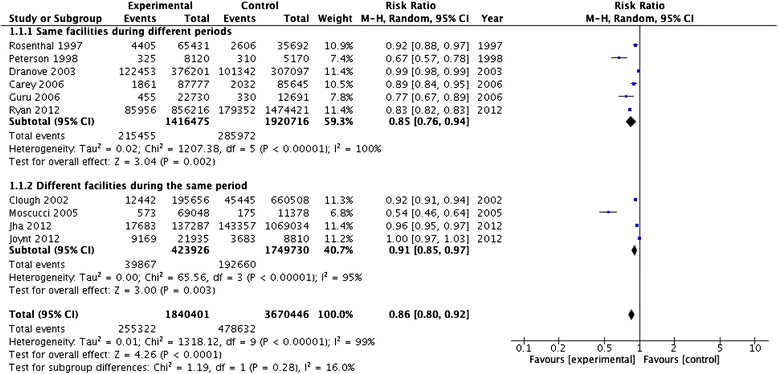The impact of Public Reporting on clinical outcomes: a systematic review and meta-analysis
- PMID: 27448999
- PMCID: PMC4957420
- DOI: 10.1186/s12913-016-1543-y
The impact of Public Reporting on clinical outcomes: a systematic review and meta-analysis
Abstract
Background: To assess both qualitatively and quantitatively the impact of Public Reporting (PR) on clinical outcomes, we carried out a systematic review of published studies on this topic.
Methods: Pubmed, Web of Science and SCOPUS databases were searched to identify studies published from 1991 to 2014 that investigated the relationship between PR and clinical outcomes. Studies were considered eligible if they investigated the relationship between PR and clinical outcomes and comprehensively described the PR mechanism and the study design adopted. Among the clinical outcomes identified, meta-analysis was performed for overall mortality rate which quantitative data were exhaustively reported in a sufficient number of studies. Two reviewers conducted all data extraction independently and disagreements were resolved through discussion. The same reviewers evaluated also the quality of the studies using a GRADE approach.
Results: Twenty-seven studies were included. Mainly, the effect of PR on clinical outcomes was positive. Meta-analysis regarding overall mortality included, in a context of high heterogeneity, 10 studies with a total of 1,840,401 experimental events and 3,670,446 control events and resulted in a RR of 0.85 (95 % CI, 0.79-0.92).
Conclusions: The introduction of PR programs at different levels of the healthcare sector is a challenging but rewarding public health strategy. Existing research covering different clinical outcomes supports the idea that PR could, in fact, stimulate providers to improve healthcare quality.
Keywords: Clinical outcomes; Healthcare quality; Public reporting; Systematic review.
Figures
References
-
- Smith P, Mossialos E, Papanicolas I. Performance measurement for health system improvement: experiences, challenges and prospects. WHO Eur Minist Conf Heal Syst. 2008;1:1–22.
Publication types
MeSH terms
LinkOut - more resources
Full Text Sources
Other Literature Sources
Research Materials




